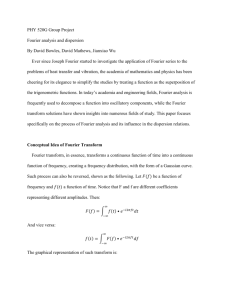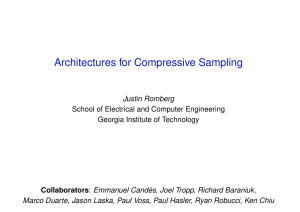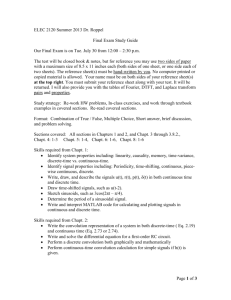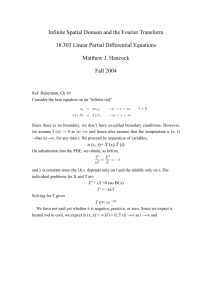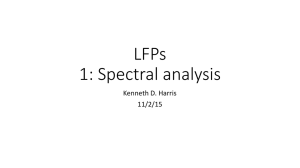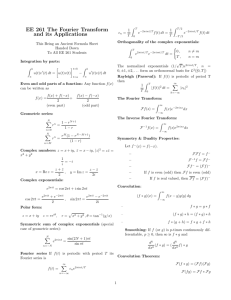PROPERTIES OF THE CONTINUOUS
advertisement
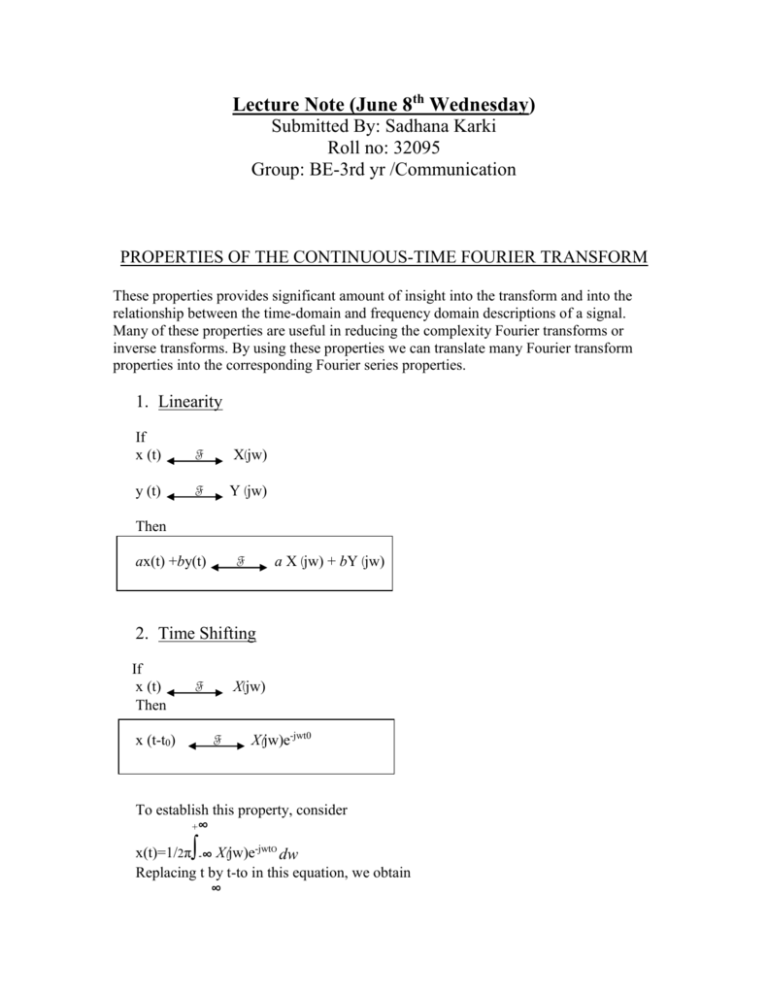
Lecture Note (June 8th Wednesday)
Submitted By: Sadhana Karki
Roll no: 32095
Group: BE-3rd yr /Communication
PROPERTIES OF THE CONTINUOUS-TIME FOURIER TRANSFORM
These properties provides significant amount of insight into the transform and into the
relationship between the time-domain and frequency domain descriptions of a signal.
Many of these properties are useful in reducing the complexity Fourier transforms or
inverse transforms. By using these properties we can translate many Fourier transform
properties into the corresponding Fourier series properties.
1. Linearity
If
x (t)
F
X(jw)
y (t)
F
Y (jw)
Then
F
ax(t) +by(t)
a X (jw) + bY (jw)
2. Time Shifting
If
x (t)
Then
F
X(jw)
F
x (t-t0)
X(jw)e-jwt0
To establish this property, consider
+∞
∫
x(t)=1/2π -∞ X(jw)e-jwtO dw
Replacing t by t-to in this equation, we obtain
∞
∫
x(t-to)=1/2π -∞ X(jw)e-jw(t-to) dw
∞
∫
x(t)=1/2π -∞ e-jwtO X(jw) ejwt dw
Recognizing this as the synthesis equation for x(t-to) ,we conclude that
F{x(t-to)}= e-jwtO X(jw)
3. Conjugation and Conjugate symmetry
The conjugation property states that if
x (t)
F
X(jw)
Then
x* (t)
F
……………………………………………………(i)
X*(-jw)
This property follows from the evaluation of the complex conjugate
∞
∫
X*(-jw) = [ x(t) -∞ e-jwt dt ]*
∞
∫
= -∞ x*(t) ejwt dt.
Replacing w by –w, we see that
∞
∫
X*(-jw) = -∞ x*(t) ejwt dt. ………………………………………….(ii)
Recognizing that the right-hand side of eq.(ii) is the Fourier transform aalysis
equation for x*(t), we obtain the relation given in eq.(i)
The conjugate property allows us to show that if x(t) is real ,then
X(jw) has conjugate symmetry: that is
X(-jw)= X*(jw)
[x(t) real]
…………………………………..(iii)
If x(t) is real so that x*(t) = x(t), we have ,from eq.(ii)
∞
∫
X*(-jw) = -∞ x*(t) ejwt dt = X(jw).
Follows by replacing w by –w
4. Differentiation and Integration
If
x (t)
X(jw)
F
then differentiating both sides of the Fourier transform synthesis equation we have
∞
∫
dx(t)/dt=1/2π -∞ jwX(jw)e-jwtO dw
Therefore,
jwX(jw)
F
dx(t)/dt
This important property replaces the operation of the differentiation in time domain
with that of multiplication by jw in the frequency domain similarly integration should
involve division by jw in frequency domain.
t
∫-∞ x(t)dt
1/jw X(jw)+π X(0) δ(w)
F
……………………………..(iv)
The impulse term on the right-hand side of eq. (iv) reflects the dc or average value
that can result from integration.
5. Time and Frequency Scaling
If
x (t)
F
Then x(at)
X(jw)
F
1/|a| X(jw/a),……………………………………………(v)
Where a is real constant. This property follows directly from the definition of the
Fourier transform
If a = -1 we have,
x (t)
F
X(-jw)
That is reversing a signal in time also reverses in Fourier Transform.
Common illustration of eq (v) is the effect on frequency content that results when an
audiotape is recorded at one speed and played back at different speed. In another way
compression in time domain can cause expansion in frequency domain and vice
versa.
I.e. high frequency signal contain wide spectrum and low frequency signal have
narrow spectrum
5. Duality
By comparing the transform and inverse transform relation we observe that these
equations are similar, but not quite identical, in form .The symmetry leads to a
property of the Fourier transform referred to as Duality (discussed in previous
lecture)
THE CONVOLUTION PROPERTY
According to the convolution property we have
y(t)= h(t)*x(t)
F
Y(w) = H(jw)X(jw).
This Eq is of major importance in signal and system analysis .The Fourier transforms
maps the convolution of two signals into the product of their Fourier transforms.
THE MULTIPLICATION PROPERTY
The convolution property states that convolution in the time domain corresponds to
multiplication in frequency domain. Because of duality between the time and
frequency domains the multiplication in the time domain also corresponds to
convolution in frequency domain.
r(t) = s(t)p(t)
F
R(jw) =1/2π [S(jw)*P(jw)]………………………………(vi)
Multiplication of one signal by another can be thought of as using one signal to scale
or modulate the amplitude of the other, and consequently, the multiplication of two
signals is often referred to as amplitude modulation. For this reason eq. (vi) is
sometimes referred as the modulation property.
Example:
Calculate the Fourier transform X(jw) for the signal x(t) .
-1
x(t) = t
for-1<t<1
Solution:
y(t)=dx(t)/dt
We know,
Analysis Equation is given by:
∞
∫
X(jw) = -∞ x(t) e-jwt dt
+1
∫
= -1 t e-jwt dt
To calculate derivative we need to calculate discontinuity, if discontinuity occurs we
have impulse at that point,
1
-1
+1
Hence y(t) is the sum of a rectangular pulse and two impulses at -1 and +1
+1
-jw
Y(jw) = -e
jw
-e
∫
+ -1 e-jwt dt
= -2coswt + {2 (e-jw - ejw)/-2jw}
=-2cosw + 2sinw/w
Note that Y (0) = -2cos (0) + 2*1
=-2+2
=0
Using Integration Property, we obtain
{sin x/x=1}
X (jw)=Y(jw)/jw + π Y(0) δ (w)
With Y (0) =0
We have
X (jw) = 2sinw/jw2-2cosw/jw
This expression for X (jw) is purely imaginary and odd, which is consistent with the
fact that x (t) is real and odd.


